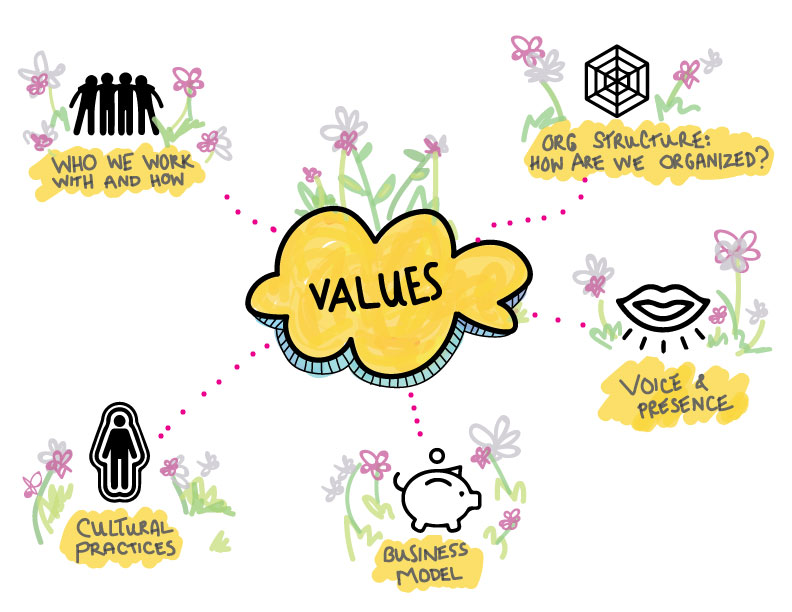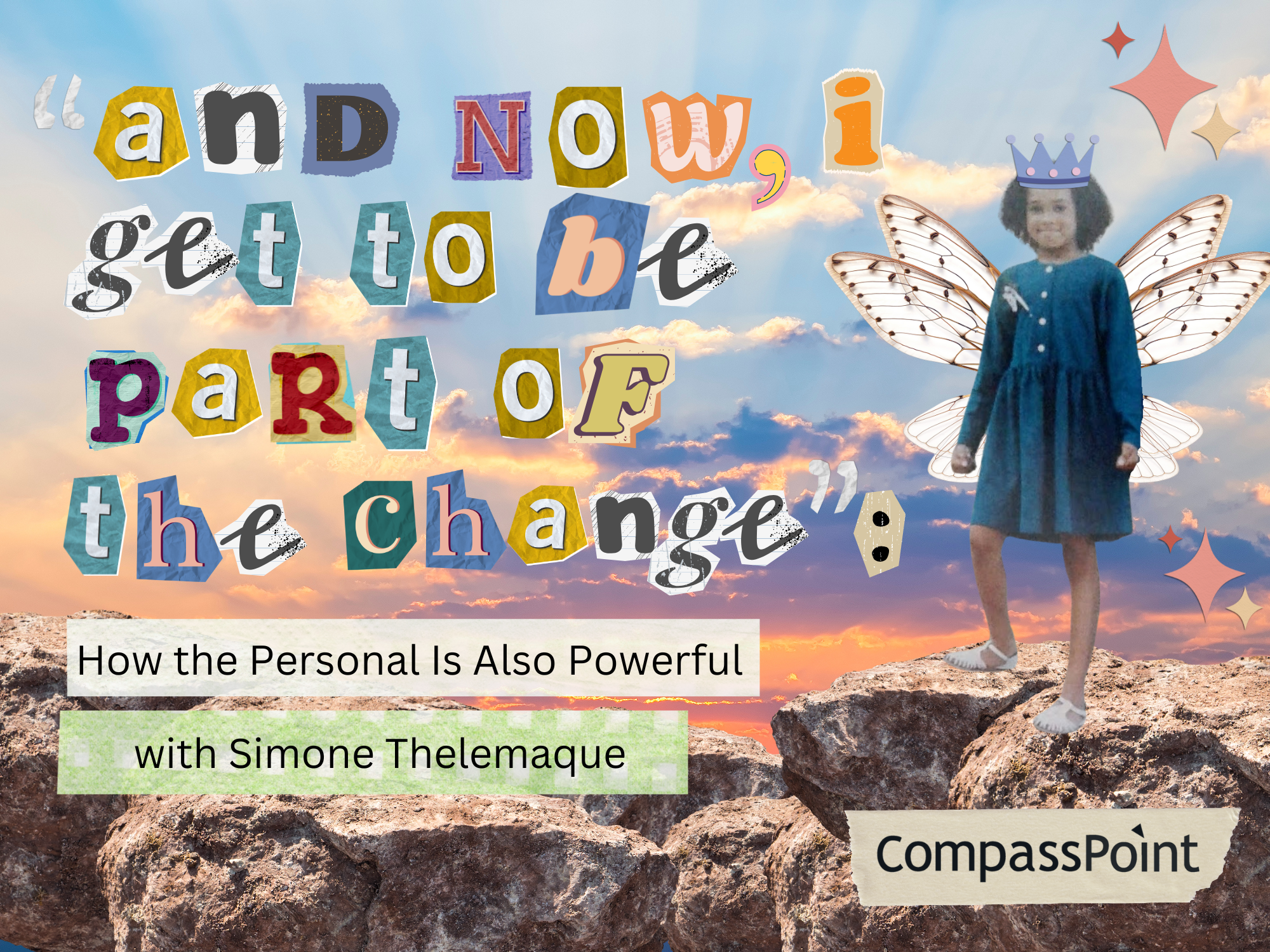What's possible when our approach to what we do starts with who we are? Paola Cubías explores how our vision and strategy process put values at the center of our work.
I’m a first generation Xicana and I’ve learned from my family that paths are made as you walk. “Caminante, no hay camino/ se hace camino al andar.” [“Traveler, there’s no path / you make the pay by walking.”] a verse from Antonio Machado’s “Caminante, No Hay Camino” is a popular refrain in a song we sing in family gatherings (a verse I later found echoed in Gloria Anzaldua’s Borderlands/Fronteras “Caminante, no hay puentes, se hace puentes al andar.” [“Traveler, there are no bridges, you make bridges as you go.”] ) These simple verses represent a lesson about change through generations; knowing that we can (trans)-form the way for ourselves and those who come next.
This is the story about how we decided to revise our vision and strategy at CompassPoint in 2017, and the process of emergence and creative resolve to develop an organizational transformation plan to:
- reimagine our collective vision (what kind of world do we want to build?),
- ground in our values (what are the principles that are the foundation for how we move toward that vision?); and
- shape a new framework for organizing ourselves where those values can live at the center and inform everything we do.
I had a front row seat and active role to that process as a member of the Vision and Strategy circle, a group of five elected staff who were charged with answering: who does CompassPoint need to be now?
"Why this change, why now?"
We formed as a group of five members: Asha, Lupe, Maro, Spring, and myself. Together we brought an array of positional and life experiences. We had the support of our peers, who had elected us, the partnership of our previous executive director (Jeanne Bell), and we had the partnership of a team of consultants in co-LAB (Maura Bairley, Monica Dennis, Viveka Chen). From the beginning, this felt fundamentally different from a traditional “strategic plan.”
For as many times as the members of our Vision and Strategy group had proclaimed our hopes for a different way of being here at CompassPoint, we didn’t have a blueprint for what we wanted to articulate. We knew—and had felt for years—that our own lived experiences and the world around us were demanding us to rethink our approach to leadership development to center racial justice and equity. Our consulting partners, co-LAB, encouraged us to answer, “Why this change, why now?” to articulate what we had been feeling in our bones for a long time. Here’s a taste of what we wrote:
“Our communities demand and deserve an approach to leadership development that centers liberation: one that nurtures people and relationships, lives at the crossroads of our urgent day-to-day needs and a visionary narrative of the future, and one that understands how our different struggles are bound up together.”
While we’ve made efforts to center social justice and name equity as a value in previous years, this felt boldly different. But what were some frames to start thinking about putting that stance at the center of our work?
Early on we thought: “We need to revise our theory of change.” But, that felt underwhelming. “Maybe we need to rewrite our mission statement”; “Wait, are we doing this for us, or for our clients?” ; “I think we need to change our style guide”...
The vision we craved needed to be carried by a collective spirit and had to be able to influence every inch of our organization—from decision-making on what vendors we use for catering, to guiding our budgeting process, to framing our program designs. We needed a way to connect each person of our practice (each one with a unique lived experience) to a common organizational perspective.
Most importantly, we knew we didn't want to re-create a strategy process where a team of powerful people disappears behind closed doors to emerge with a vision and mandate that gets handed down to everyone else. Instead, we saw our role as sourcing strategy up from our own roots; codifying the values that were already there and giving voice to aspirations about what we need to be together.
Asking Questions
In the midst of this exploration, we took a step back together to seek a destination for our process.
My fellow Vision and Strategy teammates and I met to define our outcomes for our vision and strategy process. Although the Vision and Strategy team had a clear charge, we were still swimming in murky waters. We asked ourselves, “By the end of the Vision and Strategy process, what questions do we want to be able to answer?”
So we started listing questions “Why leadership development?” “What is our business model?” “How do we meet?” “What do our clients need?” “What is our structure?” “How will we make decisions?” If these questions sound basic, know that they were fundamental to our framework and that we imagined what someone who knows nothing about CompassPoint might want to know about us.
A Deep Inner Compass
We had so many “what” questions, so many ideas we wanted to implement, but to be strategic about when and how to implement these, we needed to anchor ourselves. We knew that the “re-vision” to our vision was not simply about how we answered these questions, it was about making a statement about what drove us to answer them this way. This was about reclaiming the organizational culture of a 40-year old capacity building organization that needed to take a decisive step in solidarity with racial justice movements.
That’s why we put values at the center of our framework:
Values at the center means we hold a stance as a whole team that comes from our shared and distinct histories and experiences of privilege and oppression. Values are our common ground for how we choose to move in the world and how we choose to be with each other. This is hard. It is hard work even at the individual level to integrate your values and choices on a regular basis; it is hard to look in the mirror and acknowledge where you do and do not act in accordance with your espoused values. As an organization, it is the part of ourselves that matters most because it is our inner compass. Values at the center allows us to tap into our humanity to guide our strategies.
Tactically, this marked a critical question in our process, co-LAB asked us to reflect on the question “What do we stand for?” To answer this, we each spent time drafting and molding our set of values that reflected the spirit of our collective practice. Because values are surfaced, not prescribed, the composition of Vision & Strategy team was of utmost importance here. We each touched different parts of the organization and had experienced bright spots we wanted to lift up as we crafted our values. Together we lifted up these values:
Explore CompassPoint’s new vision and values statement here. >
Then we named the parts of our organization we wanted to impact:
Who we work with and how.
Who are the people we will partner with and what is our contribution to the partnership? What are the methodologies and what is our common approach to leading change with our partners?
Cultural practices
Cultural practices are about how we are with each other. They’re the heart of what binds us together and creates belonging.
Our structure
This is the organization’s skeleton. What systems, roles, teams, and accountabilities do we need to live into our values? This is about how we organize people, time, money. It’s about how we deal with power internally, too.
Voice and Presence
How do we show up to our community? What’s the tone and voice that we express ourselves with?
Business Model
How are we going to resource our work in a sustainable way for ourselves and our community?
What's Next?
In 2018, we have been exploring what it means to bring our values to each of these expressions of our organization. We’re planting the seeds of change across the organization and empowering the people closest to the work to make decisions about how to bring those values to life. For each of us, this means grappling with new sets of questions.
It’s not always easy to think about how values like “Radical Imagination” can apply to how we think of our business model, or our relationships with vendors, or how we think about compensation structures ... but those are exactly the kinds of questions we are trying to engage with in order name what it means for us to be a values-driven leadership and strategy practice.
And while engaging with a new set of questions across our organization can feel disorienting at first, it also comes with a renewed sense of purpose rooted in something we can always come back to: the values that draw us to this work, bind us together as a community, and call on us to not just work better, but be better.
You can explore CompassPoint’s new vision statement and values here. >
You can read more about CompassPoint’s Vision and Strategy process in this blog: “Embracing Radical Imagination.”






Submit a comment